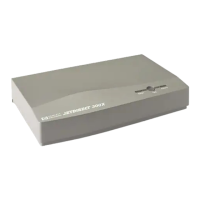For
HP
Internal Use Only
System
Abort
A system
abort
is a condition experienced
by
the
~APE/iX
operating
systern in which either
system
or
data
integrity
may
be compromised by continued operation. vVhile
the
causes of
system
aborts
are many,
the
result is always
the
same:
the
system immediately
halts
and
displays system
abort
information on
the
physical console (Ldev 20). All user activity stops.
A system
abort
message typically has
the
following format:
SYSTEM
ABORT
xxxx
FROM
SUBSYSTEM
xxxx
SECONDARY
STATUS:
INFO
=
xxxx,
SUBSYS
= xxx
SYSTEM
HALT
7,
$xxxx
{this
line
may
not
appear}
Use
the
recovery procedures
in
Table 5-18
to
resolve
the
problem.
Table 5-18. System Abort Symptoms and Solutions
Symptoms llecovery Procedure
1.
System
halts
("System Halt
7"
message).
1.
Record entire system
abort
message on
2.
All user activity stops.
console.
3.
System
abort
message
on
console (usually).
2.
Record
the
sequence
of
4-digit codes
at
4.
Orange
Fault
LED is lit.
bottom
of
console display. (Press
(Control)-@
5.
Sequence
of
4-digit codes
at
bottom
of
first.)
console display. (Press
(C'OiitrOD-@
first.)
3. Take a
memory
dump.
Refer
to
the
"Taking
a Memory
Dump"
section for more
information.
4.
Restart
the
system
when
dump
is finished.
If you have a system
abort
message on
the
console,
it
is probably unnecessary
to
copy down
the
hex display
pattern.
However,
if
there was nothing
printed
on
the
console AND
the
hex display looks like
that
above (it includes a "Bx07" sequence)
then
you have probably
experienced a system
abort
which did
not
identify itself on
the
console display. In this case,
write
the
codes down.
The
Response Center can determine
the
system
abort
number from this
information.
Taking a Memory Dump
This section provides procedures for
taking
a memory dump for
both
MPE/iX
and HP-UX
systems.
Summary
To perform a memory dump:
1.
Do a Transfer
of
Control
(TC):
a.
Type
CTRL-B
to
get
CM
>prompt
on console.
b.
Type
"TC"
and
hit
RETURN
key.
c.
If
Autoboot
is enabled,
hit
any key
to
interrupt
it.
2.
Boot from
Primary
Boot
Path:
a.
Type
"yes"
to
the
"Interact
with
IPL"
prompt.
5-22 Troubleshooting
